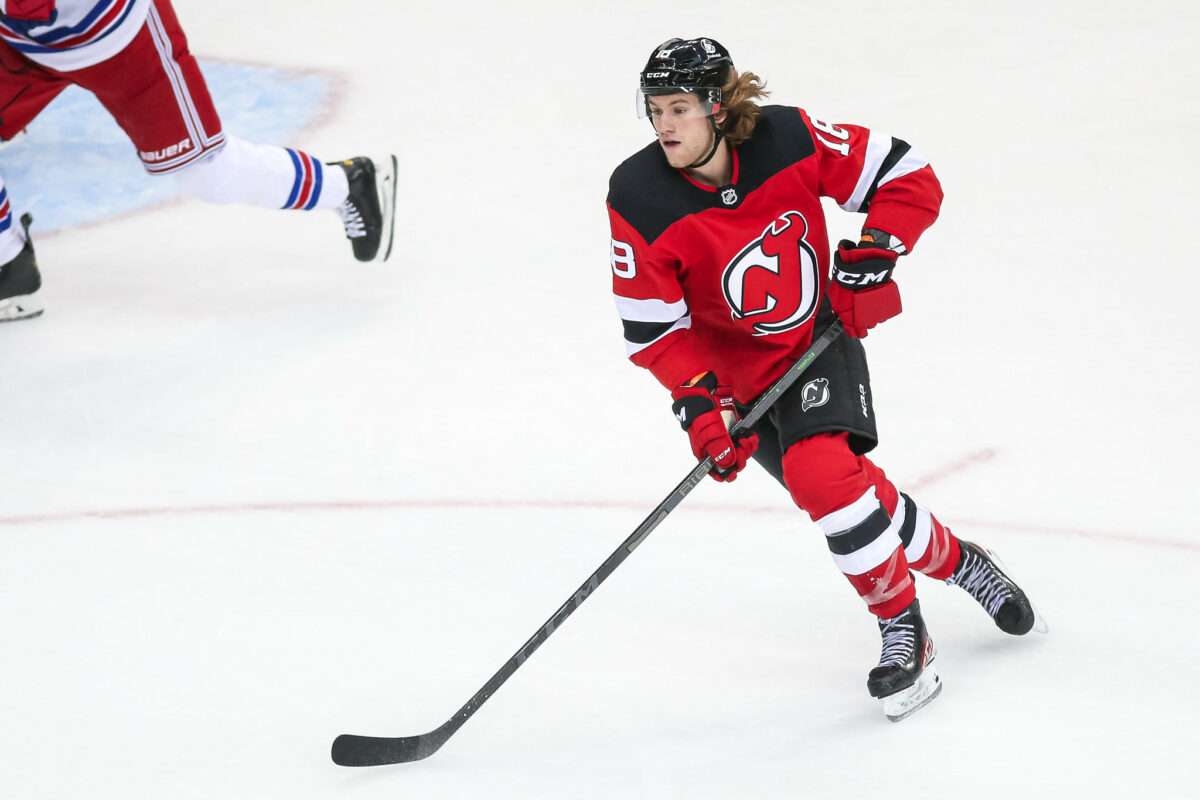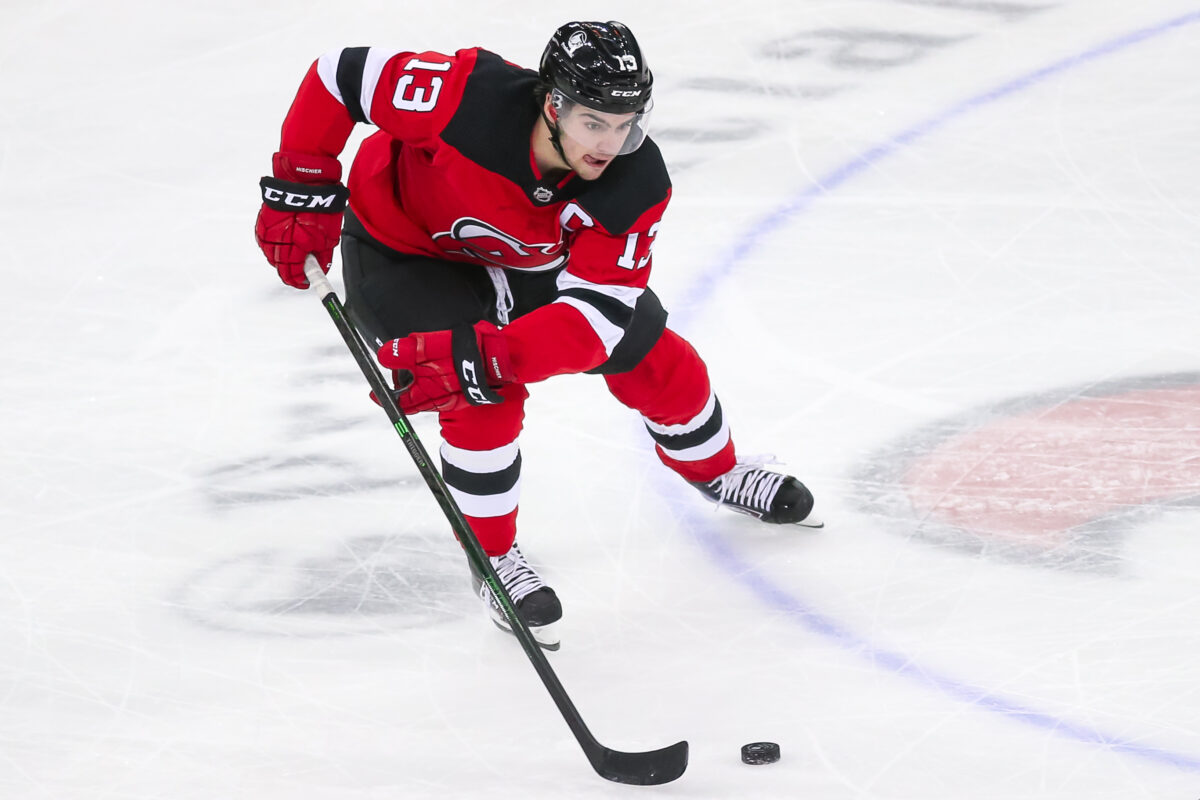The New Jersey Devils have been preaching getting off to a fast start to the 2021-22 NHL season. So far, so good, as they’ve won their first two games. But the biggest story from the first two contests of the season isn’t the Ryan Graves and Dougie Hamilton pairing or Jonathan Bernier’s strong play in net. It’s the injury Jack Hughes suffered in the team’s 4-2 win against the Seattle Kraken on Tuesday evening. After further testing, the Devils announced Hughes has a dislocated shoulder and will be re-evaluated next week.
Though Hughes won’t need surgery, it’s fair to assume he’ll miss a few games at a minimum. In any other recent season, an injury such as this one to a player of Hughes’ caliber would’ve been a death blow to the Devils’ goal to compete in the Metropolitan Division. That might not be the case this season, however. No one will mistake the Devils for being the deepest team in the league. But through strong drafting and a productive offseason this summer, they’ve improved their depth where they should be able to survive Hughes’ injury.
The Mercer Line Just Became a Whole Lot More Important
It’s very early in the season, of course. But through two games so far, head coach Lindy Ruff has been able to rely on all four of his lines at even strength, specifically his top-nine. Those units would be Hughes’ line, Nico Hischier’s line, and Dawson Mercer’s line.
Mercer may only be a 19-year-old rookie (he turns 20 in a week), but he continues to build on what was an impressive preseason. Through two games, he’s found himself on a line with Tomáš Tatar and Andreas Johnsson. We are talking about the smallest of sample sizes since there have only been two games, but their results have been nothing short of positive. They have an expected goals percentage (xG%) of 68.7 percent and Corsi for percentage (CF%) of 71.2 percent at five-on-five and are finding ways to score.

Mercer is a big part of why that line is having success. He has impressive on-ice results at five-on-five and is driving play at that game state. He’s been far from a defensive liability, which is not always the case with a player as young as him in the NHL. But he isn’t doing it alone; his linemates deserve plenty of credit too.
The Devils signed Tatar this offseason to help add some scoring punch in their top-six. So far, he’s played as well as advertised. He picked up an assist in each of the team’s two games. And his five-on-five results aren’t far off from the stellar numbers he put up with the Montreal Canadiens, where he was one of the league’s best five-on-five forwards for three seasons.
Related: Devils’ Bernier, Graves and Mercer Off to an Impressive Start
Johnsson’s start to the season may surprise some after his 2020-21 campaign, though it probably shouldn’t. Sure, his first season in New Jersey was a struggle. But so far, he looks closer to the player he was with the Toronto Maple Leafs in his two full seasons there. He has a goal and an assist to go along with Corsi and expected goals percentages above 65 percent.
Even though the production wasn’t there last season, Johnsson played well at five-on-five. Tatar’s success at five-on-five is well-noted at this point, and Mercer has shined since preseason games. The Devils certainly hope they can continue playing at this level too. Because with Hughes potentially out for a little while, they’ll become the team’s de facto second line. They won’t make up entirely for the loss of Hughes, but they can sure help soften the blow and help the Devils keep building on their 2-0-0 start.
Hischier & McLeod Will Have Key Roles Too
Towards the end of last season, Hischier, Jesper Bratt and Pavel Zacha got a run together and showed some potential. Ruff seemed to recognize that and has given them another look to start 2021-22. So far, that seems like a wise decision. Through two games, Hischier’s line has a CF% of 62.1 percent and xG% of 74.3 percent. Though they’ve only scored one goal at five-on-five, they were very much out-performing Hughes’ line, which consisted of Yegor Sharangovich and Janne Kuokkanen, before Hughes’ injury.

But despite only having one goal at five-on-five, there shouldn’t be too much concern. All three players have the potential to break out at any point. Hischier can do a bit of everything, Zacha is a shooting threat, and Bratt excels in transition and is a crafty playmaker. Given their makeups and the numbers they’ve posted so far, the points should come for them if they can keep up their play at five-on-five. The Devils will certainly need that since they’re clearly the team’s first line now.
Michael McLeod has an important role in all of this too. With Hughes out, he’ll move up to play alongside Sharangovich and Kuokkanen, at least for tonight’s game against the Washington Capitals.
That line likely won’t have the same offensive role as it did with Hughes. But you can bet they’ll have a crucial task as the third line behind Mercer and Hischier’s units. With Travis Zajac retiring this offseason, McLeod is now firmly playing the Zajac role for the Devils. That is, Ruff will be using McLeod in key defensive situations and faceoffs. But he’ll also want his line to provide scoring depth as many of Zajac’s lines did during his time in New Jersey.
And for those that don’t remember, Sharangovich and Kuokkanen played quite a bit alongside Zajac last season. It’s what got them going before Hughes eventually took over that spot after the Devils traded Zajac to the New York Islanders. McLeod may be more skilled and faster than Zajac (that shouldn’t be a surprise since McLeod is 23), but they’re similar players. McLeod is perhaps the Devils’ best center in the faceoff dot, and he’s responsible defensively like Zajac. Could McLeod find success with Sharangovich and Kuokkanen as Zajac did a season ago? If he does, the Devils should have a solid enough third line to back up the top-six made up of the Hischier and Mercer lines.
Devils Have the Pieces in Place
You’d be crazy to argue losing Hughes isn’t a blow to the Devils. But in other seasons, the team likely wouldn’t have stood a chance of losing someone of his caliber (see: Taylor Hall in 2018-19), even if it were only for a few games. The Mercer line is the key since they’ll have an elevated role and will have to keep scoring as the new second line.
Related: Top 10 Highest Scoring NHL Games of the Modern Era
But don’t discount Hischier and McLeod’s parts in this either. If those two lines also do what they’re supposed to do, the Devils should be able to survive without Hughes for however long he’s out. That’s especially true since the team’s fourth line could have some rough nights ahead of them with McLeod moving up the lineup. Time will tell if the Devils can manage better this season, but the pieces are there. And that’s something we couldn’t have said with Devils teams of the recent past.
* * *
Advanced stats from Evolving-Hockey